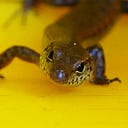Member-only story
Caught in mid-flight
But not by the camera
Look closely at this dragonfly. A big insect and a powerful flier, but a single thread of spider’s web halted it and held it fast.
Yes, I deprived the Garden Orb Weaver of its meal by cutting the tether. And yes, I did what I could to clean the dragonfly’s wings.
But the sticky liquid silk remained. It was impossible to remove.
Dragonflies are visual insects. Their compound eyes are almost hemispherical, giving an almost 360 degree field of vision. The dorsal (upper) and lower (ventral) halves of the eyes have different sensitivities to colour. Dorsal ommatidia are good at detecting ultra-violet through to blue-green, which lets them pick out prey against the sun-infused sky. Those below the optic equator can pick up a wide range from UV through to red. Ocelli (the non-compound eyes visible here as white dots between the main eyes) are only equipped for long-wavelength light from orange to red.
In flight, dragonflies can operate each of their four wings independently. This gives them incredible manoeuvrability. They can hover, as you might expect, but they can also fly backwards.
After selecting prey, the hunting dragonfly adjusts its flight to keep the image in the same spot on its visual field. Intercept trajectories are 95% successful. Having…
